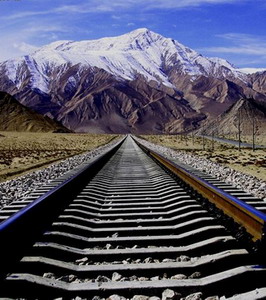Qinghai-Tibet Railway opens

-
Name:Qinghai-Tibet Railway
-
Route :Xining to Lhasa
-
Length :1956 km (1215 mile)
-
Overview:Construction of the 815 km (506 mi) section between Xining and Golmud was completed by 1984. The 1142 km (709 mi) section between Golmud and Lhasa was completed bywas completed on 12 October 2005.
Qinghai-Tibet Railway opens
Saturday, July 1, 2006
China on Saturday opened the world's most elevated railway with the first pair of passenger trains traveling across the "roof of the world".
Two trains set off at Golmud and Lhasa, the two start-up points of the Qinghai-Tibet Railway that is dubbed an "engineering marvel" that has linked Tibet with the rest of China for the first time.
A passenger train coded "Qing 1" pulled out from the Golmud station at 11:05 a.m., carrying about 600 passengers including role models of builders of the railway, representatives from the Chinese government, journalists from official media organizations including Xinhua News Agency and CCTV, in addition to ordinary passengers who bought their own tickets.
Plates inscribed with the words of "Eight Honors and Eight Disgraces", standards set by President Hu Jintao to boost socialist morality, were hung in the cars of the train, which is scheduled to arrive in Lhasa at midnight.
Before the train left, Hu made a keynote speech at a launching ceremony of the railway, and cut the red ribbon for the opening of the railway.
The opening to traffic of the Qinghai-Tibet Railway, Hu said, is another magnificent accomplishment we have achieved in our socialist modernization drive. Construction of the Qinghai-Tibet railroad is a long-cherished dream of generations of the Chinese people.
"The project is not only a magnificent feat in China's history of railway construction, but is also a great miracle of the world's railroad history," he told an audience of 2,600 on a square in front of the Golmud railway station.
Some 1,142 kilometers away, Tibet's regional capital Lhasa saw off a train bound for Lanzhou, capital of northwest China's Gansu Province, at 11:12 a.m.. The train, coded "Tibet 2", carries about700 passengers in 16 compartments and is expected to arrive in Lanzhou in 30 hours.
Norbu, a 28-year-old Tibetan farmer from Gonggar, left home before daybreak to join the celebrations at Lhasa railway station and to catch a glimpse of the train. "I'll board a train myself sometime to visit the inland areas."
Xie Yuke from Qinghai provincial railway administration, 35, a Han Chinese, is piloting the train's maiden trip on the plateau. Among the passengers are Tibetan herdsmen, farmers, retired governmental officials, builders of the railway and journalists.
Trains traveling across the roof of the world, with extra oxygen pumped into the cabins to prevent passengers from suffering altitude sickness, will traverse a mountain pass sitting 5,072 meters above sea level as it rises up to the Tibetan plateau, and will drive through the Hoh Xil, China's largest area of uninhabited land.
The cars were installed with environment-friendly toilets, wastewater deposit tank and garbage treatment facilities to protect environment along the railroad.
All the Chinese characters that appear on the electronic screen in each railway car have been translated into Tibetan and English.
The Qinghai-Tibet railway is 1,956 kilometers long, with 960 km of the track located 4,000 meters above the sea level and the highest point at 5,072 meters. The project is dubbed an "engineering marvel" because people used to think the perennial ice and slush along the route could never support tracks and trains.



